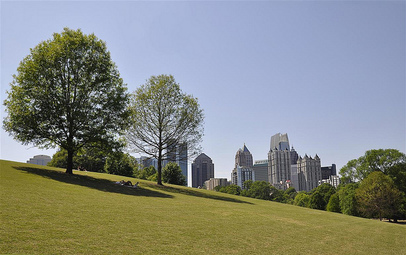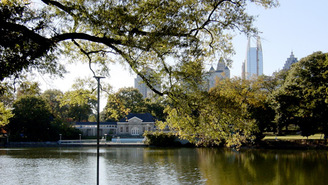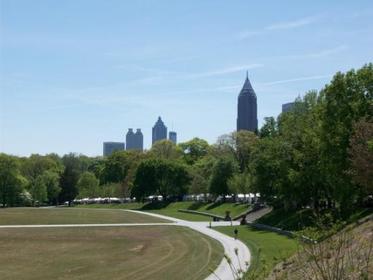Piedmont Park - Atlanta, GA
Piedmont Park in Atlanta, Georgia is a large public park located within a close distance to the heart of the downtown core of the city. It is located about a mile northeast of downtown and scenic views of the city skyline are available from many vantage points throughout the park. The park commands a 189-acre presence in the area and has long been established in the fabric of urban Atlanta. It is an historic open space that provides city residents with a valuable outlet for recreation, exercise, relaxation, and various other pursuits.
The park was completed by 1895, placing it among the top tier of urban parks that were implemented before 1900. The original purpose of the park was to provide a space for expositions to showcase the city and the surrounding region to outsiders and visitors. In the early 1900s, the park began a redesign effort led by the sons of Frederick Law Olmsted, the famous mind behind New York's Central Park and many other notable sites. The plan culminated in the addition of new landscaping and the addition of scenic paths and trails that wind throughout the park. As a result, the park became and continues to be a favored running and exercise outlet for residents of Atlanta. A large park had become a necessity in the rapidly growing city. Between 1860 and 1890, the population jumped from 9,000 to over 65,000 people. The city was rapidly becoming one of the most important cities in the South, and it desired to have grand public places to befit such an image. The preserved open space became the site for notable organized sporting events, such as the first baseball game between University of Georgia and Georgia Tech.
The park was completed by 1895, placing it among the top tier of urban parks that were implemented before 1900. The original purpose of the park was to provide a space for expositions to showcase the city and the surrounding region to outsiders and visitors. In the early 1900s, the park began a redesign effort led by the sons of Frederick Law Olmsted, the famous mind behind New York's Central Park and many other notable sites. The plan culminated in the addition of new landscaping and the addition of scenic paths and trails that wind throughout the park. As a result, the park became and continues to be a favored running and exercise outlet for residents of Atlanta. A large park had become a necessity in the rapidly growing city. Between 1860 and 1890, the population jumped from 9,000 to over 65,000 people. The city was rapidly becoming one of the most important cities in the South, and it desired to have grand public places to befit such an image. The preserved open space became the site for notable organized sporting events, such as the first baseball game between University of Georgia and Georgia Tech.
|
A significant highlight of the park is Lake Clara Meer, which is entirely within the park. It is very well-maintained and features an historic boathouse along its perimeter along with a pavilion, covered picnic areas, and a pedestrian bridge that crosses over it. The lake was originally a pond but was expanded to over 11 acres in preparation for the 1895 Cotton States and International Exposition. Park users are drawn to the lake area due to its boardwalk, a Visitors Center, and grand views of the downtown skyline. As Atlanta is not a waterfront city, the lake provides access to a waterway within city boundaries. This is valuable, as people are naturally drawn to waterfront areas.
|
The park has expanded since its creation and it continues to make efforts to expand currently, as the city realizes the jewel it is and the economic effect it has on the surrounding area. Atlanta is a city that has grown incredibly in size and importance since the late nineteenth century when the park opened. Now it can legitimately lay claim to being the cultural and economic capital of the south. The metropolitan area has transformed into a massive sprawl in each direction from the heart of downtown. As a result the region experiences some of the worst traffic in the country, as well as other negative qualities associated with massive growth in the age of the automobile. However, Piedmont Park is still intact from a time when Atlanta was a different place, and it's importance and role in the city's quality of life is just as pivotal as ever.



